|
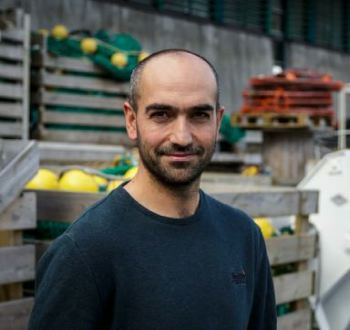
Manu Sistiaga leads the Norwegian pilot experiment on live storage of bluefin tuna.(Photographer: Erlend A. Lorentzen / HAVFORSKNINGSINSTITUTTET
Will catch 250 kilo bluefin tuna - and store them alive in cages
 NORWAY
NORWAY
Wednesday, September 16, 2020, 15:00 (GMT + 9)
The following is an article published by Havforskningsinstituttet (English translation from the original norwegian)
- If we manage the critical point, to get the bluefin tuna up the transport cage, we get to the rest, says catch researcher Manu Sistiaga.
On September 20, he and a bunch of research colleagues will get on the fishing boat "Vestbris". They will try something that has never been done before in Norway, with the biggest specimens of the world's largest tuna: Getting them up in a cage.
"This is done with bluefin tuna in the Mediterranean, but under completely different conditions. There, the fish are smaller, and stand together to spawn", the researcher explains.
It is the largest individuals of 250-350 kilos that add the grazing migration to the species' northern outer border, Norway.
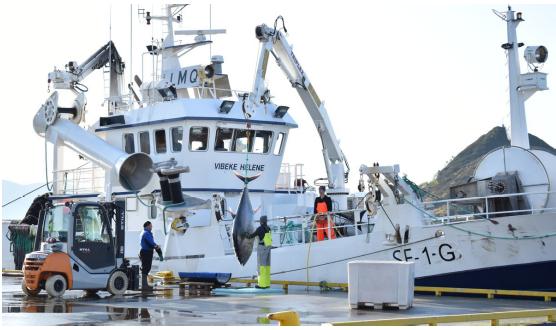
The F/V 'Vibeke Helene' delivers the catch at the reception in Sandshamn during a 2019 season.Photographer: Manu Sistiaga / Institute of Marine Research
"As we have documented before, there are many challenges in today's fishing, especially related to quality and profitability", says Sistiaga.
- It is difficult to control how many or rather how few fish you catch at a time.
- It is complicated work to get the fish on board and kill them efficiently and gently. This affects the quality of the meat, and price.
- The market is often filled with a lot of fish at one and the same time, which also gives fishermen a lower price.
So-called live storage is a possible solution to these problems. But certainly no simple matter. Here is the attack plan:
1. Find and catch bluefin tuna
First, researchers and fishermen must find the super-fast fish relatively close to land in the Måløy area, where they will store them.
Then they must succeed in surrounding the fish with the net. This in itself is something the fishermen have spent a lot of time on in recent seasons. They must also not catch too many fish.
"We have an experimental quota of up to six tonnes, which in practice means 20-30 fish", Sistiaga explains.
It is difficult to calculate the sizes of the shoals on the sonar, especially when the fish are in the net. The boat and the tool create turbulence and noise in the sea, which affects the sonar.
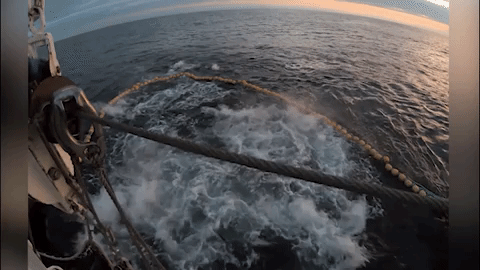
Stock Photo: This is what it looks like when bluefin tunas are caught together. (Video: Manu Sistiaga / HI)
"Before we catch a shoal, we must take advantage of the combined expertise of the fishermen and researchers on board the «Vestbris».
The fishing boat also has a bluefin tuna quota. They can harvest the fish if it becomes most expedient.
2. Sew seam and transport cage together
Both the bluefin tuna net and a collapsible transport cage of 140 meters in circumference are equipped with each half of a transmission channel - a total of a 12 meter long «tunnel».
"When the fish are caught in the net, we have to go out in a light boat and sew the connection between the net and the cage. HI researchers have done this before with mackerel and herring. It should go well in good weather", Sistiaga explains.
3.Make the fish swim through the canal
Now we come to the part where we talk about the middle ground. The researchers must make the fish swim into the tunnel and out into the transport cage.
"And we must do that without squeezing the net too much. Then the noises can become stressed, wrap themselves in the net wall and die", Sistiaga explains.
The researchers are to some extent at the mercy of the fish's will and behavior. But it can also work to their advantage.
"Bluefin tuna is a shoal fish. If one goes through, the rest will probably follow. We have toyed with the idea of using a fake bluefin tuna that we pull through the canal", he says.
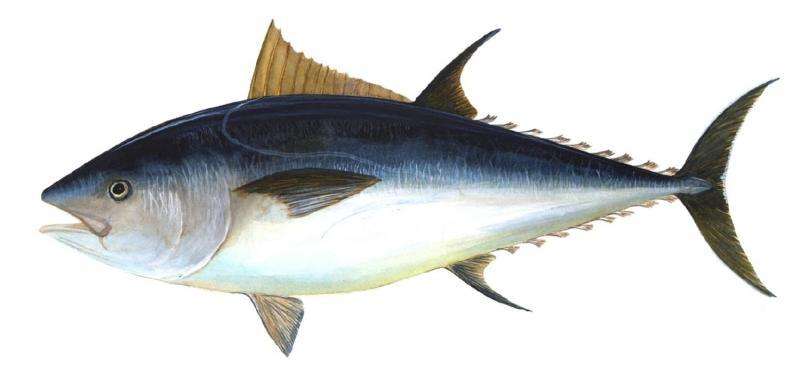
Atlantic bluefin tuna (Photo: Public domain)
The Atlantic Tuna Commission ICCAT manages bluefin tuna. They set strict requirements for documentation of fish to be stored in cages. The transmission channel is therefore equipped with a stereo camera from Mohn Technology that will count the fish and measure their length as they pass.
4. Get the fish ashore
When the critical point is over, the fish is secured in a transport cage. It must "Vestbris" tow ashore. Slowly.
"We will tow the fish to Runderheim by Måløy in one knot. That is why we prefer to catch them as close as possible to where we will end up", Sistiaga explains.
"We depend on good weather and patience. But if we have come this far, we have low shoulders".
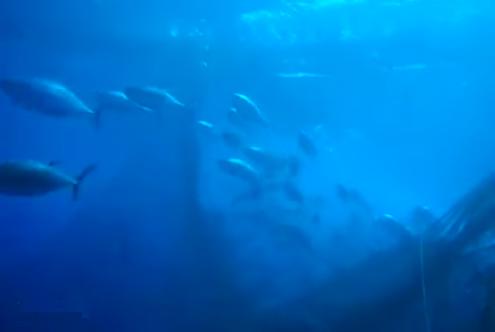
Bluefin tunas entering nito a farming cage (Photo: public domain)
5. Transfer the fish to a storage cage
While the transport cage is light and collapsible, the final storage cage is solid cases.
At the storage cage, it will be the same procedure with connection and transfer, but here at ease.
"Here too, the stereo camera will measure the fish. Do we get the same result, and do the fish have visible damage or signs of stress? These are the research questions", says Sistiaga.
Analyze the meat of killed fish
The bluefin tunas will then go into the cage at Domstein Sjømat for a short period before most are released. A few fishermen will be killed with various methods that will safeguard quality, animal welfare and HSE.
If they get this far, researchers and fishmongers will eventually analyze the meat and compare the quality of the fish landed through the commercial fishery.
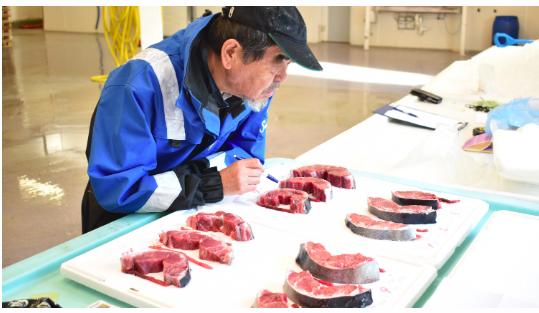
Japanese expert assesses the quality of bluefin tuna meat to determine which fish can go to auction in Japan. (Photo: Manu Sistiaga / HI)
Live storage is the future
"This is an ambitious project with very many factors that must be true. But we have to start somewhere", says the researcher.
"Each phase has many of its own research questions, so even if we do not succeed in everything, we will learn something", he continues.
Sistiaga believes that live storage can provide a more sustainable and profitable bluefin tuna fishing when it can supply the market steadily with top quality fish.
"It will be able to provide better animal welfare, profitability, and perhaps make it easier to build up the Norwegian and European market for bluefin tuna .
It is a great paradox that we import beef from Uruguay and send our bluefin tuna to Japan. Here we must know our visiting time", the researcher believes.
Author: Erlend A. Lorentzen / Havforskningsinstituttet (Institute of Marine Research)

editorial@seafood.media
www.seafood.media
|



